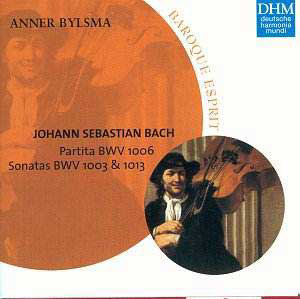Anner Bylsma, the Dutch cellist, has recorded two of
the finest interpretations of Bach’s solo suites for cello. His sensitivity,
emotion, and energetic playing make him one of the best performers of
Bach’s works. This recording features three works, all arranged by Bylsma
for the violoncello piccolo: the first and third pieces were originally
written for solo violin, and the middle piece is the only solo work
for flute that Bach wrote.
There is no need here to discuss the validity of these
transcriptions - Bach transcribed much of his own work, and, with the
exception of the flute sonata, the transcription is not very radical.
But the use of this instrument - which Bylsma used on his first recording
of the cello suites, for the final suite - makes this disc very interesting.
The instrument used is actually a 19th century children’s cello, with
gut strings, which gives it a unique tone.
Bylsma is not in his finest here, however. His intonation
is off in the higher notes of the E major partita. While the movements
in the lower ranges sound excellent, and quite full of energy, he struggles
in the higher end of the instrument, and the result is not always attractive.
He plods through the minuets, but the second movement, the loure, is
sinuous and seductive. He is much better in the final movements, the
bourrée and gigue, where the rhythm carries him away. The A minor
sonata suffers from the same problems of intonation, though the overall
playing is more lively. The long fugue is well-played, but the higher
end of the instrument is a bit screechy. The pulsing andante is quite
attractive, and Bylsma maintains an alluring rhythm.
The G minor sonata, originally written for solo flute
in A minor, is the gem of this disc. Who would have thought that this
work could sound so good on a string instrument? Bylsma’s arrangement
is excellent, and his playing radiant. From the very first notes, one
can hear that Bylsma is at home with this work - the sound is quite
different from the partita, in fact, and highlights the instrument much
more. Bylsma is smooth and lyrical in the long opening allemande, his
legato playing espousing the subtle curves of the melody. In the other
movements, his playing is at the same standard - unlike in the opening
partita, his intonation is close to perfect. The sarabande of this sonata,
in Bylsma’s performance, is one of the most moving sections of any of
Bach’s solo works. Bylsma here transcends music to reach a plane of
such perfection, emotion and beauty, that this listener remained transfixed
by his performance. Slow and sensual, his tone is perfect, his bowing
ideal, this movement is powerful and subtle.
One comment on the notes to this disc - there is not
even a list of the movements of the different works, let alone their
timings. While there are a few pages of interesting comments about the
instrument, it wouldn’t be too difficult to include the basic information
that one expects to find in a recording: a track list, timing, recording
information, etc.
This disc is a mixed bag. Anner Bylsma is excellent
in his rendition of the flute sonata, but his performance of the solo
violin works leaves a bit to be desired. At its budget price, this is
a valuable addition to any Bach discography, in spite of its imperfections.
Kirk McElhearn


